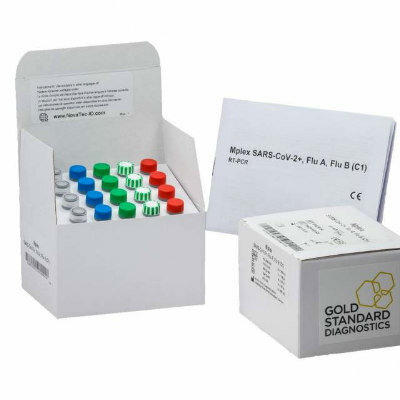Only Saliva-Based Rapid COVID-19 Test in the Market Delivers Highly Accurate Results in 15 Minutes at POC
|
By LabMedica International staff writers Posted on 29 Nov 2021 |

A game-changing platform is revolutionizing point of care testing for COVID-19 and other diseases, delivering high accuracy, high speed at a low cost.
KAYA17 (Livermore, CA, USA) has developed a complete point of need testing solution for COVID-19 that comprises a new POC test platform for antigen testing with breakthrough performance, a 15 minute saliva-based antigen test, cartridge and software/app. KAYA17 provides a complete immunoassay test kit containing all disposables and reagents and controls needed, in packs of 25 or 50 tests. Its proprietary reagents are fine-tuned for ease of use by staff with minimal training while maintaining high sensitivity and specificity.
KAYA17's rapid solution is not a strip test that is based on a color changing indicator. The Kaya17 nCoVega Test, the only saliva-based rapid COVID-19 test in the market, uses a high-sensitivity reader with very low false negative information, allowing even asymptomatic patients to be detected. The reader is compact, low cost, and runs off USB power. KAYA17 has designed a proprietary one-time use Vertical Flow Cartridge (VFC) on which the sample is processed, keeping the reader free during this time. The cartridge is inserted into the electronic reader for one minute. The patient ID QR code label is placed on the cartridge to ensure that the sample can be traced at all times. KAYA17’s high sensitivity reader allows its VFF cartridges to be read with high accuracy and speed.
The reader is integrated with the company’s proprietary software which is embedded in the supplied laptop. The patient registration software gathers patient information and generates a unique patient QR code that is applied to their sample tube and cartridge used to process their sample. The software can also receive this information from a QR code from a patient portal app. The KAYA17 patient portal app has two functions. It helps make patient registration fast, seamless and contactless. Patients can enter their profile information a priori before coming for a test. The second function of the app is to display the results of a test. After the test is completed, the patient does not have to wait for their results at the test site. Results will be automatically sent to their phone. The patient portal app is available in both iOS and android platforms.
KAYA17’s system allows parallel testing with multiple readers. One patient ID computer can be connected to 10 readers operating in parallel. The results from all of the readers are transmitted to the patient ID computer where a report is generated for each patient. Results of the test can be printed as a patient test report, sent to their phone, or synched up with a central hospital or healthcare database. One KAYA17 reader can run 30 tests per hour at a testing site and can be scaled up to 300 tests per hour with 10 readers, thus making it an ideal candidate for rapid testing at airports, resorts, events, cruise lines, stations, schools, workplaces, and hospitals.
The KAYA17 technology base goes beyond COVID-19 testing, using the same platform, and has a wide range of applications. With a minor change to the reagents, rapid point-of-care tests can be developed for other medical diagnostic targets. No change will be required for the cartridge and reader. This allows the technology to be used in the rapid diagnosis of several other diseases and conditions as well, with the same level of accuracy and efficiency. KAYA17 has received the CE Mark for its Kaya17 nCoVega Test and has submitted the test for FDA EUA approval with commercial shipments commencing in the US. The company has plans for licensing the Kaya17 platform for other tests and is developing tests for hepatitis B, UTI, cardiac markers, influenza A & B, nora virus, strep throat, staph infection, and sepsis for the US and other markets. It is also developing tests for cervical cancers, UTI, hepatitis B & C, HIV, food bacteria (E. Coli, salmonella, listeria), water testing, dengue and chikungunya for the developing countries.
Related links:
KAYA17
Latest COVID-19 News
- New Immunosensor Paves Way to Rapid POC Testing for COVID-19 and Emerging Infectious Diseases
- Long COVID Etiologies Found in Acute Infection Blood Samples
- Novel Device Detects COVID-19 Antibodies in Five Minutes
- CRISPR-Powered COVID-19 Test Detects SARS-CoV-2 in 30 Minutes Using Gene Scissors
- Gut Microbiome Dysbiosis Linked to COVID-19
- Novel SARS CoV-2 Rapid Antigen Test Validated for Diagnostic Accuracy
- New COVID + Flu + R.S.V. Test to Help Prepare for `Tripledemic`
- AI Takes Guesswork Out Of Lateral Flow Testing
- Fastest Ever SARS-CoV-2 Antigen Test Designed for Non-Invasive COVID-19 Testing in Any Setting
- Rapid Antigen Tests Detect Omicron, Delta SARS-CoV-2 Variants
- Health Care Professionals Showed Increased Interest in POC Technologies During Pandemic, Finds Study
- Set Up Reserve Lab Capacity Now for Faster Response to Next Pandemic, Say Researchers
- Blood Test Performed During Initial Infection Predicts Long COVID Risk
- Low-Cost COVID-19 Testing Platform Combines Sensitivity of PCR and Speed of Antigen Tests
- Finger-Prick Blood Test Identifies Immunity to COVID-19
- Quick Test Kit Determines Immunity Against COVID-19 and Its Variants
Channels
Clinical Chemistry
view channel
3D Printed Point-Of-Care Mass Spectrometer Outperforms State-Of-The-Art Models
Mass spectrometry is a precise technique for identifying the chemical components of a sample and has significant potential for monitoring chronic illness health states, such as measuring hormone levels... Read more.jpg)
POC Biomedical Test Spins Water Droplet Using Sound Waves for Cancer Detection
Exosomes, tiny cellular bioparticles carrying a specific set of proteins, lipids, and genetic materials, play a crucial role in cell communication and hold promise for non-invasive diagnostics.... Read more
Highly Reliable Cell-Based Assay Enables Accurate Diagnosis of Endocrine Diseases
The conventional methods for measuring free cortisol, the body's stress hormone, from blood or saliva are quite demanding and require sample processing. The most common method, therefore, involves collecting... Read moreMolecular Diagnostics
view channel
Unique Autoantibody Signature to Help Diagnose Multiple Sclerosis Years before Symptom Onset
Autoimmune diseases such as multiple sclerosis (MS) are thought to occur partly due to unusual immune responses to common infections. Early MS symptoms, including dizziness, spasms, and fatigue, often... Read more
Blood Test Could Detect HPV-Associated Cancers 10 Years before Clinical Diagnosis
Human papilloma virus (HPV) is known to cause various cancers, including those of the genitals, anus, mouth, throat, and cervix. HPV-associated oropharyngeal cancer (HPV+OPSCC) is the most common HPV-associated... Read moreHematology
view channel
Next Generation Instrument Screens for Hemoglobin Disorders in Newborns
Hemoglobinopathies, the most widespread inherited conditions globally, affect about 7% of the population as carriers, with 2.7% of newborns being born with these conditions. The spectrum of clinical manifestations... Read more
First 4-in-1 Nucleic Acid Test for Arbovirus Screening to Reduce Risk of Transfusion-Transmitted Infections
Arboviruses represent an emerging global health threat, exacerbated by climate change and increased international travel that is facilitating their spread across new regions. Chikungunya, dengue, West... Read more
POC Finger-Prick Blood Test Determines Risk of Neutropenic Sepsis in Patients Undergoing Chemotherapy
Neutropenia, a decrease in neutrophils (a type of white blood cell crucial for fighting infections), is a frequent side effect of certain cancer treatments. This condition elevates the risk of infections,... Read more
First Affordable and Rapid Test for Beta Thalassemia Demonstrates 99% Diagnostic Accuracy
Hemoglobin disorders rank as some of the most prevalent monogenic diseases globally. Among various hemoglobin disorders, beta thalassemia, a hereditary blood disorder, affects about 1.5% of the world's... Read moreImmunology
view channel
Diagnostic Blood Test for Cellular Rejection after Organ Transplant Could Replace Surgical Biopsies
Transplanted organs constantly face the risk of being rejected by the recipient's immune system which differentiates self from non-self using T cells and B cells. T cells are commonly associated with acute... Read more
AI Tool Precisely Matches Cancer Drugs to Patients Using Information from Each Tumor Cell
Current strategies for matching cancer patients with specific treatments often depend on bulk sequencing of tumor DNA and RNA, which provides an average profile from all cells within a tumor sample.... Read more
Genetic Testing Combined With Personalized Drug Screening On Tumor Samples to Revolutionize Cancer Treatment
Cancer treatment typically adheres to a standard of care—established, statistically validated regimens that are effective for the majority of patients. However, the disease’s inherent variability means... Read moreMicrobiology
view channel
Mouth Bacteria Test Could Predict Colon Cancer Progression
Colon cancer, a relatively common but challenging disease to diagnose, requires confirmation through a colonoscopy or surgery. Recently, there has been a worrying increase in colon cancer rates among younger... Read more.jpg)
Unique Metabolic Signature Could Enable Sepsis Diagnosis within One Hour of Blood Collection
Sepsis is a life-threatening condition triggered by an extreme response of the body to an infection. It requires immediate medical intervention to prevent potential death or lasting damage.... Read morePathology
view channel
Spatial Tissue Analysis Identifies Patterns Associated With Ovarian Cancer Relapse
High-grade serous ovarian carcinoma is the most lethal type of ovarian cancer, and it poses significant detection challenges. Typically, patients initially respond to surgery and chemotherapy, but the... Read more.jpg)
Unique Hand-Warming Technology Supports High-Quality Fingertip Blood Sample Collection
Warming the hand is an effective way to facilitate blood collection from a fingertip, yet off-the-shelf solutions often do not fulfill laboratory requirements. Now, a unique hand-warming technology has... Read moreTechnology
view channel
New Diagnostic System Achieves PCR Testing Accuracy
While PCR tests are the gold standard of accuracy for virology testing, they come with limitations such as complexity, the need for skilled lab operators, and longer result times. They also require complex... Read more
DNA Biosensor Enables Early Diagnosis of Cervical Cancer
Molybdenum disulfide (MoS2), recognized for its potential to form two-dimensional nanosheets like graphene, is a material that's increasingly catching the eye of the scientific community.... Read more
Self-Heating Microfluidic Devices Can Detect Diseases in Tiny Blood or Fluid Samples
Microfluidics, which are miniature devices that control the flow of liquids and facilitate chemical reactions, play a key role in disease detection from small samples of blood or other fluids.... Read more
Breakthrough in Diagnostic Technology Could Make On-The-Spot Testing Widely Accessible
Home testing gained significant importance during the COVID-19 pandemic, yet the availability of rapid tests is limited, and most of them can only drive one liquid across the strip, leading to continued... Read moreIndustry
view channel
ECCMID Congress Name Changes to ESCMID Global
Over the last few years, the European Society of Clinical Microbiology and Infectious Diseases (ESCMID, Basel, Switzerland) has evolved remarkably. The society is now stronger and broader than ever before... Read more
Bosch and Randox Partner to Make Strategic Investment in Vivalytic Analysis Platform
Given the presence of so many diseases, determining whether a patient is presenting the symptoms of a simple cold, the flu, or something as severe as life-threatening meningitis is usually only possible... Read more
Siemens to Close Fast Track Diagnostics Business
Siemens Healthineers (Erlangen, Germany) has announced its intention to close its Fast Track Diagnostics unit, a small collection of polymerase chain reaction (PCR) testing products that is part of the... Read more


















